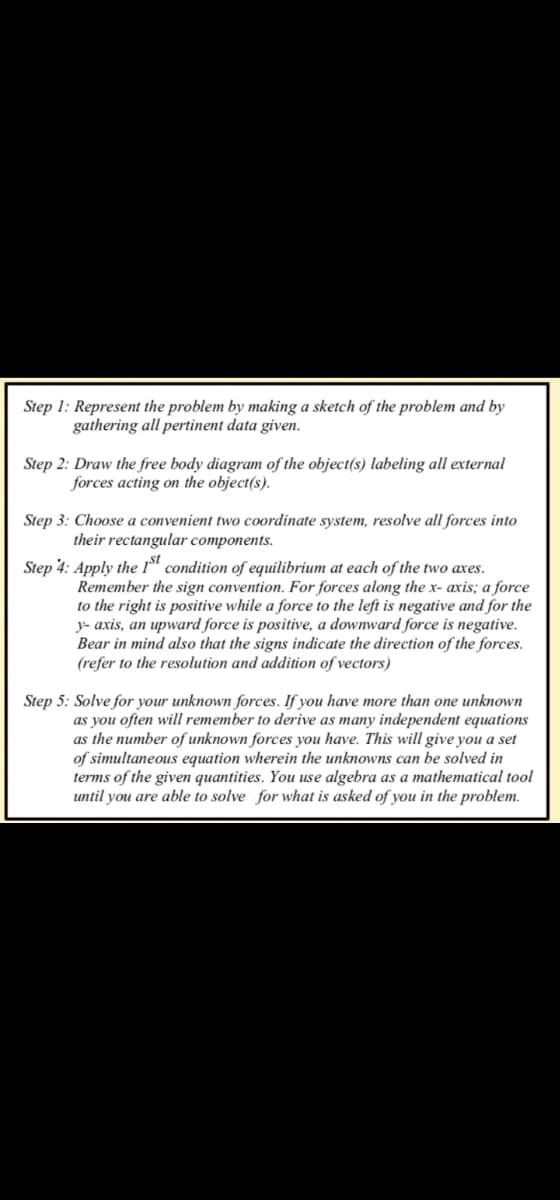1. A horizontal force of 80 lb.acts on a 50-lb object suspended by a string. What are the magnitude and direction of the force the string must provide to keep the object at rest?
1. A horizontal force of 80 lb.acts on a 50-lb object suspended by a string. What are the magnitude and direction of the force the string must provide to keep the object at rest?
College Physics
11th Edition
ISBN:9781305952300
Author:Raymond A. Serway, Chris Vuille
Publisher:Raymond A. Serway, Chris Vuille
Chapter4: Newton's Laws Of Motion
Section: Chapter Questions
Problem 20P: A horizontal force of 95.0 N is applied to a 60.0-kg crate on a rough, level surface. If the crate...
Related questions
Question
Solve the given problem by following the steps below

Transcribed Image Text:11. A horizontal force of 80 lb,acts on a 50-lb object suspended by a string. What are the magnitude and direction
of the force the string must provide to keep the object at rest?

Transcribed Image Text:Step 1: Represent the problem by making a sketch of the problem and by
gathering all pertinent data given.
Step 2: Draw the free body diagram of the object(s) labeling all external
forces acting on the object(s).
Step 3: Choose a convenient two coordinate system, resolve all forces into
their rectangular components.
Step 4: Apply the l" condition of equilibrium at each of the two axes.
Remember the sign convention. For forces along the x- axis; a force
to the right is positive while a force to the left is negative and for the
y- axis, an upward force is positive, a downward force is negative.
Bear in mind also that the signs indicate the direction of the forces.
(refer to the resolution and addition of vectors)
Step 5: Solve for your unknown forces. If you have more than one unknown
as you often will remember to derive as many independent equations
as the number of unknown forces you have. This will give you a set
of simultaneous equation wherein the unknowns can be solved in
terms of the given quantities. You use algebra as a mathematical tool
until you are able to solve for what is asked of you in the problem.
Expert Solution
This question has been solved!
Explore an expertly crafted, step-by-step solution for a thorough understanding of key concepts.
Step by step
Solved in 2 steps with 1 images

Knowledge Booster
Learn more about
Need a deep-dive on the concept behind this application? Look no further. Learn more about this topic, physics and related others by exploring similar questions and additional content below.Recommended textbooks for you

College Physics
Physics
ISBN:
9781305952300
Author:
Raymond A. Serway, Chris Vuille
Publisher:
Cengage Learning

College Physics
Physics
ISBN:
9781285737027
Author:
Raymond A. Serway, Chris Vuille
Publisher:
Cengage Learning

College Physics
Physics
ISBN:
9781938168000
Author:
Paul Peter Urone, Roger Hinrichs
Publisher:
OpenStax College

College Physics
Physics
ISBN:
9781305952300
Author:
Raymond A. Serway, Chris Vuille
Publisher:
Cengage Learning

College Physics
Physics
ISBN:
9781285737027
Author:
Raymond A. Serway, Chris Vuille
Publisher:
Cengage Learning

College Physics
Physics
ISBN:
9781938168000
Author:
Paul Peter Urone, Roger Hinrichs
Publisher:
OpenStax College

Physics for Scientists and Engineers, Technology …
Physics
ISBN:
9781305116399
Author:
Raymond A. Serway, John W. Jewett
Publisher:
Cengage Learning

An Introduction to Physical Science
Physics
ISBN:
9781305079137
Author:
James Shipman, Jerry D. Wilson, Charles A. Higgins, Omar Torres
Publisher:
Cengage Learning